Trip Logs
Antarctica, South Georgia & the Falkland Islands Trip Log: January 16–31, 2019
January 17, 2019 | Ushuaia, Argentina
We converged on the small city of Ushuaia, the gateway to Antarctica. Our flights provided a dramatic panorama. Clouds parted every so often, revealing the breathtaking southern Andes. The glaciers, lakes and soaring peaks had to be seen to be believed, and the mesmerizing scenery seemed to go on forever.
Ushuaia is a growing outpost filled with restaurants and shops catering to travellers with an adventurous spirit. Enjoying the unique distinction as the southernmost town in the world, Ushuaia is locally known as El Fin de Mundo — The End of the World. Interestingly, the name means “inner harbor to the westward” in the native Yaghan tongue. The town has grown rapidly in recent years, but still maintains its frontier-town feel, with streets of small houses and every kind of architecture. On the hillside behind the old town, untidy clusters of new houses appeared in the clearings within the native forest.
By late afternoon, we boarded our beautiful ship, ‘Le Lyrial’ for our luxury Antarctica cruise. Inside, we were shown to our cabins, where our complimentary parkas, backpacks and water bottles had been neatly arranged. Once we had settled in, we toasted the start of our expedition with a celebratory glass of Champagne in La Comète, one of two restaurants on board. After exploring the ship, we gathered for a mandatory lifeboat drill at the muster station, where we learned how to don life vests and navigate to the lifeboats.
Next, we met in the theater. Expedition Director Suzana Machado D’Oliveira welcomed us aboard, and Cruise Director Paul Carter outlined the luxury facilities available to us as well as the routine of daily life at sea. Paul was followed by Expedition Leader Dr. Marco Favero, who explained how changing conditions in this part of the world, such as weather and ice, require his team to work closely with the Captain to create flexible backup plans.
‘Le Lyrial’ headed east down the Beagle Channel, which separates Tierra del Fuego from the rest of South America. The straight is named for ‘Beagle,’ a Cherokee-class brig-sloop commissioned by the Royal Navy to survey the coast of South America. It was here, on this voyage, where Charles Darwin shaped his theory of evolution. After dinner, we retired to our cabins early for a good night’s rest.
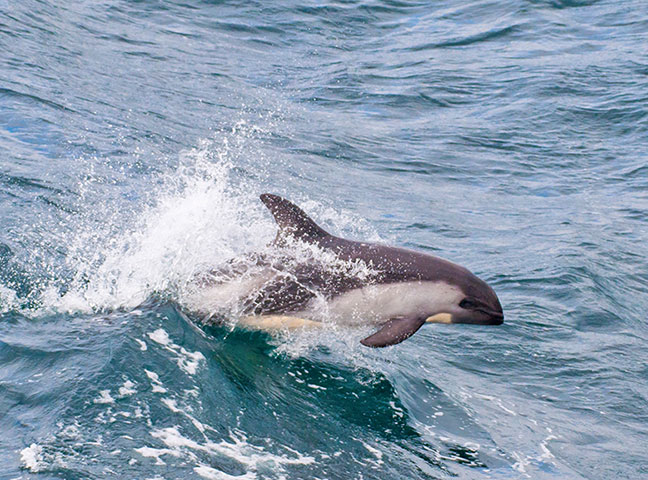
January 18, 2019 | At Sea
By early morning, we had passed Staten Island to the north and were in open waters. It was comforting to realize that our ship was steaming on an even keel, and a peek through the window revealed very little swell. Our first day at sea began with the parka exchange. The A&K Expedition Team doled out weatherproof parkas. This would provide protection from the harsh elements, and was especially important for those guests who were not acclimated to cold climates. The jackets were also bright red, so we would be easy to spot ashore. We could request insulated rubber boots and rain pants; these would provide additional protection and greater stability on uneven ground.
We gathered for the enrichment lecture program, which would take place on those days spent at sea. Ornithology lecturer Dr. Maria Patricia (Patri) Silva Rodriguez presented “Seabirds of the Southern Ocean.” She introduced us to a large group of Procellariiformes, incredible seabirds that would accompany ‘Le Lyrial’ throughout the cruise. The group includes the giant albatross and many smaller species such as the black-and white-checkered Cape petrel, gray prion and the diminutive storm petrel. One of the more unique characteristics of the Procellariiformes is their tube-shaped nostrils, which have a well-developed sense of smell. Some species among this group use this ability to locate their nesting sites at night. They are even better known for their effortless flight capabilities, dependent on the winds that sweep over the vast oceans of our world. Patri went on to share some of their history, paying special attention to the most common species we may see out here in the Southern Ocean.
Photo coach Richard Harker presented “Photographing South Georgia and Antarctica: What to Expect and How to Prepare.” We enjoyed a preview of the exciting things we may see throughout our expedition, and Richard provided us with tips on how to photograph in the region’s unpredictable weather.
After lunch, we heard from geology lecturer Wayne Ranney during his lecture entitled “The Wandering Falkland Islands.” He showed how the sequence of rock layers discovered in the Falklands mimic those found today on South Africa’s eastern seaboard. Interestingly, this is shown to be true only when the Falkland Islands are rotated 180 degrees from their present-day orientation. One of the clues was a unique layer of glacial deposits that was 300 million years old. This layer revealed that the supercontinent of Gondwana broke up about 200 million years ago. The Falklands block remained attached to South America but rotated as Africa pulled away.
We were treated to afternoon tea, and then returned to the theater for a briefing by Suzana concerning our visit to Stanley, the only town in the Falkland Islands. History lecturer Bob Burton presented “The Falkland Islands Medley,” a quick overview of the archipelago’s chaotic history. Naturalist guide Pete Clement came next. A Falkland Islander by birth, he discussed what life is like living on the islands. Sheep farming was once the major source of income before fishing vessels acquired licenses to trawl the open seas. Pete also informed us that oil extraction from the seabed is primed to commence once the economic climate becomes favorable.
It was time for the Captain’s Welcome Aboard Cocktail Party. During this social gathering, Captain Mickael Debien introduced the senior officers who would be running the ship. Conversation was buzzing, and we were becoming fast acquainted with our fellow guests. After the party, we made our way to Le Céleste and La Comète for dinner, an exquisite meal befitting a French ship.
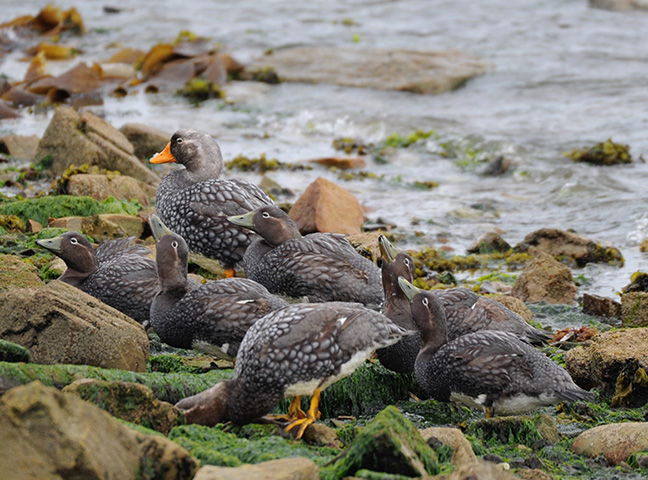
January 19, 2019 | Stanley, Falkland Islands
In the morning, ‘Le Lyrial’ headed up the channel of Port William. Then the ship turned 90 degrees in order to pass through a straight called “the Narrows” and into the spacious harbor of Port Stanley. Because of the stiff northerly wind, it was impossible to moor alongside the dock, so we anchored in the middle of the harbor instead. Once the ship had been cleared by customs and immigration, we were permitted to go ashore via tender in the small waterside town of Stanley. During a brief formality, we displayed our cabin ID cards to the security officers stationed there.
Buses soon arrived to ferry us to a variety of tour sites: one to a few battlefields from the Falklands War in 1982, another to a sheep farm, and several others to penguin colonies and other wildlife havens. The most popular tour was the visit to the rockhopper penguin rookery — our only opportunity to see this attractive species. Rockhoppers are among the smallest of the penguin species, and really stand out with their yellow crests and red-orange beaks.
Stanley is home to 85 percent of the 3,000 inhabitants living in the Falkland Islands. The old town of mainly corrugated iron buildings has expanded rapidly in the last 20 years, and is now surrounded by modern houses.
We could purchase souvenirs and last-minute necessities from the stores, and enjoy lunch or a drink at one of the pubs, cafés or restaurants. Sightseeing included visits to the museum, Christ Church Cathedral and other points of interest. As an unexpected bonus, we got to see a small pod of black-and-white Commerson’s dolphins. There was even a mother with her small calf swimming right behind. This species lives around many islands in the South Atlantic and is known to make circles around boats. To our amusement, these dolphins spent the entire day following our tenders to and from the jetty.
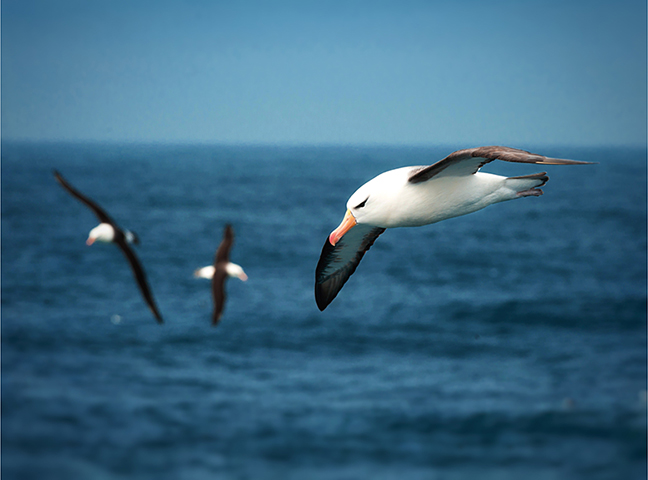
January 20, 2019 | At Sea
Our luck held in the morning. The sea remained calm, and ‘Le Lyrial’ rolled gently over the waters. Among the wildlife spotted by the naturalists was a distant sei whale, along with a wandering albatross. The most magnificent of ocean birds, the wandering albatross boasts the largest wingspan of any living bird. Adhering to set times of the day, the naturalists would gather on the pool deck at the stern to point out birds and whales to interested guests and help them identify their species. Richard, along with our other photo coach, David Salmanowitz, were present to assist with photography. Experts of their trade, they were knowledgeable about a range of different devices, including smartphone cameras, single-lens reflex cameras (SLRs) and the heftier 300-millimeter lens. With the kind permission of Captain Debien, our group was allowed on the bridge to see how the ship operated. The invitation also gifted us with better odds of capturing more stunning photos.
Meanwhile, enrichment lectures were taking place in the theater. Larry Hobbs, marine mammal lecturer, presented “Elephants, Lions and Leopards: The Seals of the Southern Ocean.” The lecture covered the seals we would encounter on the cruise, including fur seals and elephant seals in South Georgia. We learned that fur seals have small external ears. They swim using their fore flippers and tuck their hind flippers under their bellies to run quickly on land. Once we reached Antarctica, we would discover other seal species: Weddell, crabeater and leopard. Unlike their fur seal cousins, these true seals do not have external ears. They also swim using their hind flippers and move relatively slowly on land. Larry provided some fascinating and graphic details pertaining to the feeding and breeding habits of these various species.
After lunch, Bob presented “Shackleton: Heroic Failure?” Sir Ernest Shackleton, the Irish-born explorer, is famously connected with South Georgia. In fact, many guests join the Antarctica cruise specifically for this reason. Shackleton is most famous for having rescued his crew from ‘Endurance’ after the ship got trapped in the clutches of the Weddell Sea. Nevertheless, he actually took part in four expeditions to Antarctica, beginning with Captain Robert Falcon Scott’s first expedition. Shackleton eventually led three of his own, including one in which he nearly succeeded in reaching the South Pole.
Sadly, Shackleton perished during his final expedition in South Georgia. Renowned for his charisma, determination and leadership, he remains a hero to many for having rescued his men from the treacherous Weddell Sea. While he is sometimes called a failure because he did not attain any of his objectives, he was undeniably brave, and cared deeply for the welfare of his crew.
Richard came in from the deck for his second presentation: “Photographing South Georgia and Antarctica: Mastering Your Camera.” Covering the various settings on our cameras, Richard showed us how to take the most beautiful photographs of Antarctic wildlife and landscapes, and the lecture was geared toward both point-and-shoot and digital SLR audiences.
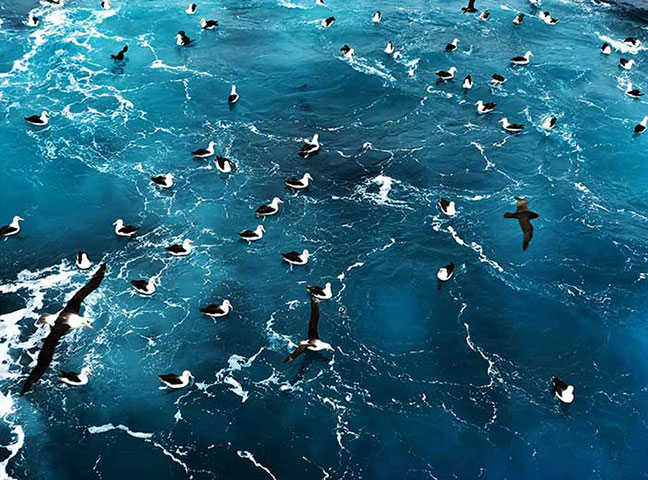
January 21, 2019 | Shag Rocks, South Georgia
We awoke to overcast skies, with a pall of high gray clouds and little wind or swell. ‘Le Lyrial’ drew near to Shag Rocks after breakfast. Jutting out like a row of shark’s teeth, these six rock pinnacles lie 150 miles west of South Georgia, and are stained white with the guano of 2,000 nesting blue-eyed shags. As we slowly circled the rocks, numerous birds flew overhead, including shags, wandering albatrosses, black-browed albatrosses, giant petrels, white-chinned petrels, and prions.
We enjoyed amazing views of humpback whales feeding close to the rocks. Altogether, 10 humpbacks and two fin whales were spotted by the naturalists. Soon, the ship’s echo sounder revealed swarms of krill near the surface. We learned that the underwater neighborhood attracts a profusion of wildlife due to the upwelling of water from a nearby ocean trench. This surge transports nutrients to the surface, promoting the growth of phytoplankton on which krill feed. These krill, in turn, attracted the pod of whales to our location, so this natural chain reaction certainly worked in our favor.
By midmorning, we joined Suzana in the theater to learn how the Zodiacs work — rubber inflatable boats that we would use to make our landings throughout South Georgia and Antarctica. Juan José (JJ) Apestegui, Assistant Expedition Leader, demonstrated how to dress appropriately for landings. Marco capped things off with a briefing dedicated to biosecurity regulations.
When the briefing was over, an announcement buzzed over the PA advising of a spectacular wildlife spectacle taking place near the deck. Everyone collected their parkas, binoculars and cameras and made their way outside. In what someone described as “humpback soup,” mighty blows from humpback whales could be seen all around us, stretching across the horizon. Larry believed that there may have been as many as 200 whales in our presence, with 100 given as a conservative estimate. A number of seabirds accompanied us, wheeling about the ship and landing in great numbers to feed. Luckily for these birds, the whales, along with the propeller on the ship, were driving krill to the surface, which is where the buffet was taking place. Even the A&K Expedition Team, with years of collective experience sailing Antarctic waters, had never witnessed such an extraordinary sight.
Patri presented an essential introduction to penguins: “Birds in Tuxedos: Why Do They Look So Different?” She highlighted some of the species we would encounter. We learned about Adélie penguins, which march many miles over the sea ice in October to reach their breeding colonies; macaroni penguins, which lay two eggs of differing sizes; and the emperor and king penguins, the two largest of the penguin species.
In the afternoon, Bob presented “The Island of South Georgia: The Jewel in the Crown,” the title of which alluded to the island’s superb location within the territories controlled by the United Kingdom. The first landing on the island was made by James Cook in 1775, whose visit precipitated the arrival of American and British sealers who wiped out the island’s populations of fur seals and elephant seals. Shore-based whaling stations operated here from 1904 to 1965, where more than one hundred thousand whales were brought ashore and processed primarily for their oil.
The British administration attempted to regulate whaling, but was thwarted by the development of pelagic factory ships that could operate outside national waters. Since the 1970s, South Georgia has been targeted for krill, Antarctic cod, mackerel icefish and Patagonian toothfish. Early overfishing had once run rampant. Recognizing the threat to both the fishing industry and underwater ecosystem, the government of South Georgia intervened and successfully brought this problem under control. It is now possible to purchase toothfish sourced from the island’s sustainable fishery. This fishing ground employs measures to prevent albatrosses from being snagged on longline hooks.
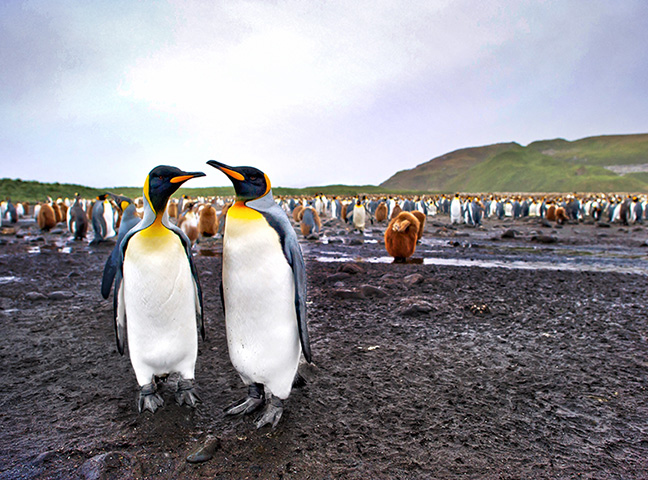
January 22, 2019 | Salisbury Plain & Fortuna Bay
The weather this morning was poor. A sheet of low clouds descended and enveloped the surrounding scenery in a ghostly fog. The early hours saw ‘Le Lyrial’ anchored in the Bay of Isles on the north coast of South Georgia. We were lying off Salisbury Plain, a large expanse of flat ground between the sea and mountains. This is the site of a huge colony of some 60,000 pairs of colorful king penguins.
Conditions for our first Zodiac cruise were less than ideal. While the sea appeared calm, a low swell broke hard across the beach. In a well-rehearsed plan of action, we bore witness to the proficiency and coordination of the A&K Expedition Team and shore crew as they led our boats safely to our landing site.
Once ashore, we strolled through a colony of fur seals to reach the penguins and watched their small black pups meandering about. After a short walk along the back of the beach, we had reached the breeding colony. Scores of king penguins were bunched up in the thousands. Brown, woolly chicks mingled with adults stretching far up the hillside. A symphony filled the air, a combination of the whistling of hungry chicks and the kazoo-like braying of males courting females. A lucky few spotted South Georgia pipits, sparrow-like songbirds found nowhere else in the world. Until recently, these birds were rarely seen because they were preyed upon by rats accidentally introduced to the colony area by sealers and whalers many years ago. In a massive project spanning many years, the South Georgia Heritage Trust managed to eradicate these pests, and today, the pipits are quickly recolonizing.
The amazing wildlife spectacle was backdropped by rugged mountain and glacier scenery. At the back of the plain, the hills were divided by Lucas Glacier and Grace Glacier. Flowing north into Ample Bay, Grace Glacier is named for the wife of American ornithologist Robert Cushman Murphy, who undertook much of his research here in 1912.
During a delicious lunch, ‘Le Lyrial’ steamed east along the coast to Fortuna Bay, famous for lying on the same route as Shackleton’s epic South Georgia crossing of 1916. König Glacier lies behind a broad plain at the back, which only enhances the gorgeous scenery. Surrounded by mountains, the three-mile-long, one-mile-wide fjord is much more sheltered than the Bay of Isles.
The wind was acting up and rain broke from the heavens. Luckily, we were only a short Zodiac cruise away from the bay. Though the king penguin colony was only 1.5 miles from our position, a dense fog materialized, and the colony visit had to be abandoned for safety reasons. There was still much to see along the shore. And we managed to find shelter in a cave once occupied by sealers two centuries prior. Inside, elephant seals huddled in small groups and fur seal pups frolicked about. Most heartwarming for the A&K Expedition Team were the large flocks of South Georgia pintails.
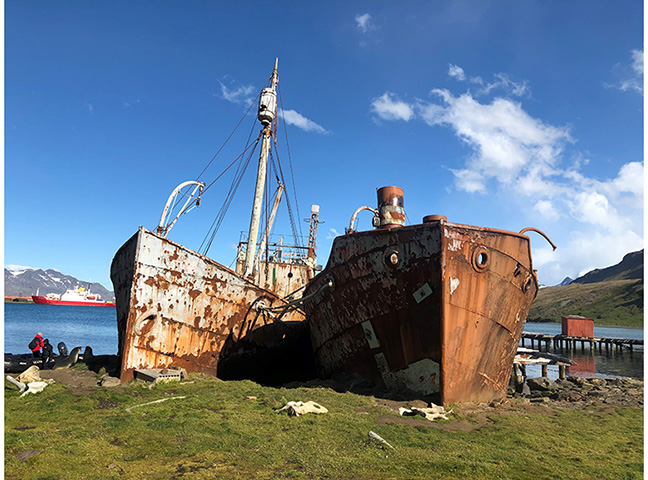
January 23, 2019 | Stromness Bay & Grytviken
‘Le Lyrial’ had spent the night at anchor in Husvik Bay, and headed for Stromness Bay in the early morning. We awoke to a good omen: The clouds were breaking up, and a colorful rainbow streamed up Shackleton Valley. For our first excursion, we would hike the valley and make our way to the same waterfall that Shackleton, Frank Worsley and Tom Crean descended. The walk back traced their route to the Stromness whaling station. Weary from their journey, Shackleton and his men had looked rather unkempt — their clothes were tattered rags, hair was tangled and faces were black with blubber smoke. Inside, they were met by the manager, Thoralf Sorlle, with welcoming words: “Who the hell are you?” Sorlle eventually came around though, and provided them with food, shocking news of World War I, and the best hot bath they ever took.
Clouds were beginning to clear, revealing distant mountaintops and colorful vegetation that climbed the shores and valleys. Our walk took us past sleeping fur seals and their bleating pups, small groups of molting king penguins, and the occasional pipit or pintail.
We enjoyed a lunchtime cruise in Stromness Bay. In the early afternoon, ‘Le Lyrial’ entered King Edward Cove. We made our way to Grytviken, a disused whaling station where the British maintain a small research station and a team of government officials. Today, it is also something of a tourist attraction, albeit a quiet one. Emma Jones, who works for the British government, came aboard to clear us for entry into the port and ensure biosecurity regulations were being met. This included checking our parkas, rain trousers, backpacks, walking sticks, and camera tripods for seeds and foreign contaminants.
Free to go ashore, our first stop was Grytviken Cemetery. Here lies the grave of Shackleton himself, along with those of many whalers who lost their lives in the pursuit of whale oil. Shackleton died of a heart attack in Cumberland Bay in 1922, just six years after rescuing his crew from the doomed ‘Endurance.’ While Shackleton’s body was en route to England, a telegram was received from his wife, Emily, insisting that he be laid to rest in Grytviken Cemetery. Interestingly, the ashes of Frank Wild — leader of the party from Shackleton’s shipwrecked expedition — had been interred there just a few years prior, and the two gravesites lay beside one another to this day.
Some of the more physically active chose to hike up a steep slope to Gull Lake, a reservoir for a hydroelectric plant. Built by whalers a century ago, a new plant has since been established to reduce the station’s reliance on fossil fuels, such as imported coal.
Others headed straight for the museum. We worked our way through the various rooms, admiring the remarkable records and natural history displays. We also stopped by the shop to browse a myriad of attractive souvenirs ranging from books, clothing and ornaments. Postcards and South Georgia stamps, which are something of a collector’s item, could be purchased at the post office and shipped from the island, although mailing times bring new meaning to the term “snail mail.”
Museum director Sarah Lurcock from the South Georgia Heritage Trust offered a guided tour of the whaling station for anyone interested. The station had been cleared of asbestos and other dangerous material, but much of the machinery once used for processing whale carcasses into oil had been left behind. After, we visited the Whalers Church, a Norwegian church restored more than twenty years ago. Appealing to our simple pleasures, those who fancied the notion could ring the church bells.
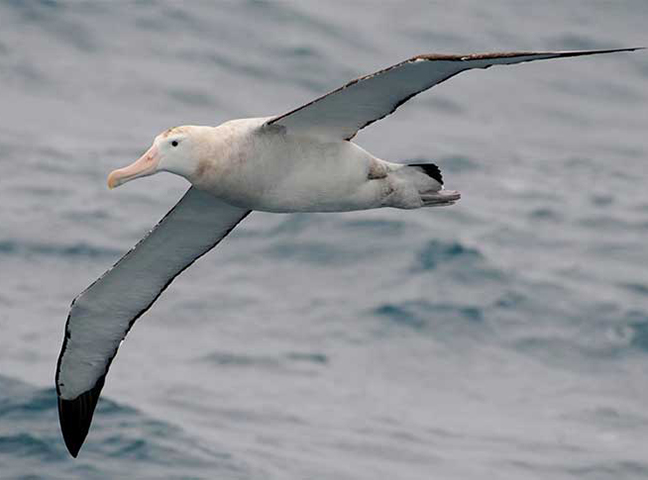
January 24, 2019 | Crossing the Scotia Sea
Today, we would experience true expedition cruising. The original plan had been to make an early landing at Gold Harbour, a beautiful refuge where elephant seals and a king penguin colony could be found. Unfortunately, powerful gusts and a heavy swell threatened our landing, so we were forced to deviate from the program.
By way of an alternate route, we proceeded up the stunning Drygalski Fjord. As ‘Le Lyrial’ cruised along the coast, Mother Nature revealed her true power. Waves broke over the side of the ship, and water and white foam erupted from the sea. It didn’t take us long to realize that a visit to the fjord was now out of the question. At once, the Captain set course for Antarctica. Despite the powerful waves in our midst, ‘Le Lyrial’ proved remarkably resilient, and we hardly felt any movement.
The wind slowly waned over the course of the day, and the sun came out from the cloud cover. On the open sea, a “team” of seabirds put on a breathtaking show filled with precision flight maneuvers; the dramatic waves provided the perfect foreground for this surprise spectacle. A wandering albatross had been tailing our ship for some time, its brilliant white plumage catching the occasional ray of sunlight. Boasting a wingspan of eight to 11 feet, the great bird rose and dipped over the waves with outstretched wings for minutes on end, with barely any effort.
As we sailed away from South Georgia, the winner of spot-the-first-iceberg was announced: Alex Holzman, who was rewarded with a top-shelf bottle of Champagne from the Captain himself. Several miles long, the tabular iceberg Alex had spotted was at least as large as ‘Le Lyrial.’ These icebergs break off huge ice shelves around the coasts of the Weddell Sea and drift northward over a span of several years. These icebergs occasionally become grounded in shallow water around the island. Otherwise, they continue on their present course before slowly melting in warmer water to the north.
To help compensate for the lost time in South Georgia, the enrichment program recommenced with Bob. In “My Favorite Heroes: The Heroic Age of Antarctic Exploration,” he examined what was arguably the most intriguing era of Antarctic history — the time of Amundsen, Scott and Shackleton from 1895 to Shackleton’s death in 1922. We learned about a few extraordinary journeys, two from Scott’s Last Expedition. During the Winter Journey, three men trudged through a bitter Antarctic night to collect emperor penguin eggs; Scott’s Northern Party spent the winter in a snow hole; and Australian explorer Sir Douglas Mawson embarked on an incredible solo trek back to base after his two companions had perished — a triumph of mental strength over physical adversity.
Next, Larry presented “Marine Mammals of the Southern Ocean: Where Blubber and Bad Hair Days Are Not a Problem.” Providing an overview of the evolution of whales, Larry also identified the two main types of whales: toothed, which include dolphins and porpoises; and baleen, which consume krill and fish using a sieve. We were already ecstatic to have seen a humpback whale while feeding, and there was still the possibility of encountering a blue whale and even an orca, one of Antarctica’s top predators.
January 25, 2019 | Crossing the Scotia Sea
‘Le Lyrial’ proceeded across the Scotia Sea in a more sedate fashion than yesterday. The swell had died down, and the ship was barely rolling. Occasionally, the clouds would part to reveal a pale sun, which flashed across the open sea beyond.
The enrichment lectures would be interspersed with on-deck wildlife spotting. Wayne started us off with “Rocks and Ice: Through Time in Antarctica.” He continued his story of Gondwana, and also included fascinating information about sea ice, icebergs and glaciers. Sea ice begins to form around Antarctica in April and September and doubles the size of the continent, which is already the size of the United States and Mexico combined. We also heard about some of the past climates Antarctica has experienced, along with the large coalfields and petrified forests that formed during warmer years.
Bob followed suit with “The Antarctic Treaty.” He went on to explain the 1959 signing of this accord, penned by the 12 countries that had dispatched scientists to study the barren tundra during the International Geophysical Year. Among other provisions outlined in the treaty, the agreement declared that “Antarctica shall be used for peaceful purposes only.” Bob explained how the Antarctic Treaty works to regulate activities such as tourism, and how 53 nations were able to come to an agreement. Somehow, in a world beleaguered with war, Antarctica has managed to avoid any real conflict.
In the afternoon, Larry discussed the history of whaling dating back to the earliest records of aboriginal whaling; the golden days of commercial whaling; and finally, the bloody era of industrial whaling. In each era, Larry outlined the relationship between whale and whaler, from a spiritual connection to one predicated on the ruthless demands of industry. We also learned about some of the other threats facing whales in our oceans today, including overfishing and toxic compounds such as DDT and PCB. Happy to share his opinions with us, Larry believes that in order for humans to manage our resources sustainably, we need to incorporate the sensibilities from each whaling era — interconnectedness, creativity and restraint — into our relationship with the other species on the planet.
Naturalist guide Russ Manning had the honor of the afternoon’s final presentation: “A Year in Antarctica.” He shared stories about his nearly twenty-five years of living and working on the continent. During the 1990s, Russ served at three British research stations, and was base commander of two of them before he began working aboard cruise ships. He painted a vivid account of life in these isolated communities, detailing the perils and pitfalls along with the highlights of working in such a wonderful environment.
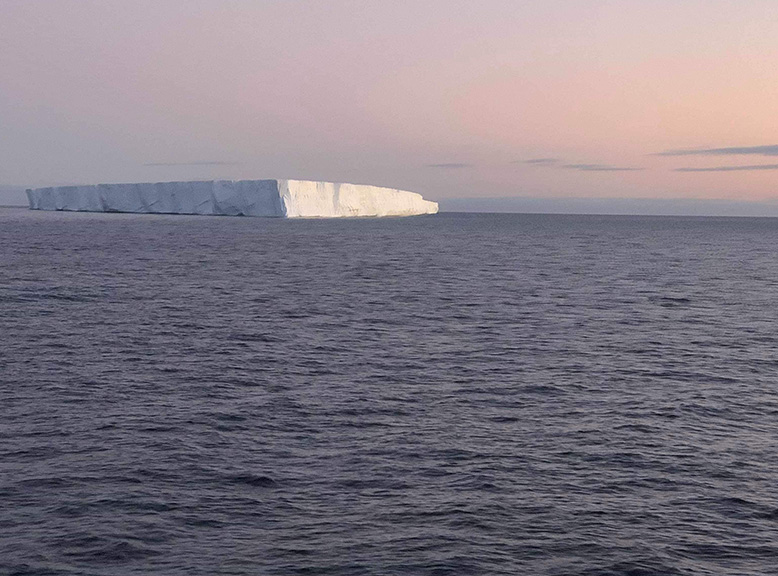
January 26, 2019 | Penguin Island, South Shetlands
The swells had been unexpectedly high throughout the night, something which had not been forecasted. Luckily, the sea settled during the day. Once again, ‘Le Lyrial’ showcased its remarkable strength and steamed gracefully across the waves. However, we were heading into shaky weather, and our progress was slowed.
After breakfast, ‘Le Lyrial’ passed Clarence, Cornwallis and Elephant islands at the eastern end of the South Shetlands. With mountainous islands and shimmering glaciers, each island is beautiful to behold, but also extremely inhospitable. Shackleton made landfall here on Elephant Island, which is named for the large number of elephant seals found along the shoreline. When his men became stranded on the northern coast’s Point Wild, they camped there for four months until Shackleton rescued them aboard the Chilean vessel ‘Yelcho.’ As we sailed past the south side of the island, Cape Valentine came into view.
Later, Patri presented “Penguin II: Evolution and Biology.” Her talk helped us understand penguin behavior, and she introduced the various penguin species found throughout the world. We learned about their distribution, population and history, along with the characteristics unique to each species. Patri went on to discuss diving capabilities, breeding biology, and molting and feeding habits.
Richard came next with a practical and timely lecture entitled “The Perfect Penguin: Using Composition to Turn Snapshots into Art.” With Richard’s help, we would transform our digital photos into dramatic shots that would really impress our family and friends.
As the only afternoon event, Bob’s presentation took center stage. In “Rescued by Penguins: The Unsung Story of Penguins in the Heroic Age,” he took a fresh, novel approach to Antarctic history, noting that when things went south on the early expeditions, large numbers of penguins usually suffered as a result. In order to survive, Shackleton and other Antarctic explorers began picking these hapless creatures off one by one, feasting on their flesh and using their blubber and skins as fuel.
Looking out the windows, we could see our approach to Penguin Island. The island lies at the eastern end of King George Island, the largest of the South Shetlands. As we had disembarked from South Georgia quite early and were not hindered all that much by the adverse weather, we were able to work in the additional landing for what should have been a day at sea. Penguin Island plays host to a small colony of chinstrap penguins. Its most notable feature, Deacon Peak, is a well-preserved 557-foot summit crater, and after a quick hike up the slope, we got to look down the cone.
Dinner had to be rearranged due to the landings, but the kitchen staff were happy to accommodate.
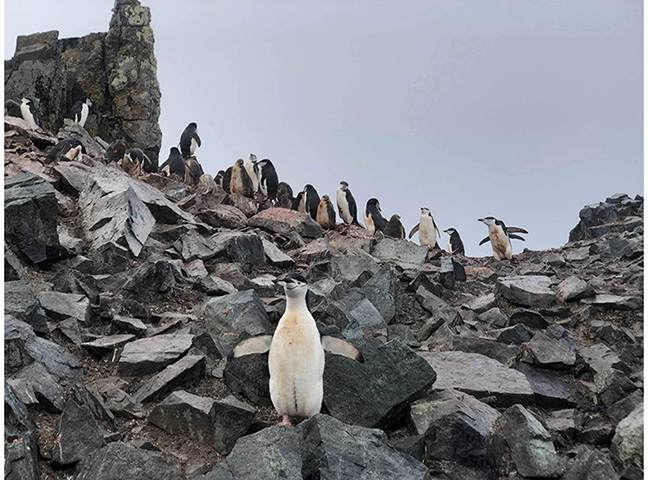
January 27, 2019 | Half Moon Island & Deception Island
‘Le Lyrial’ cruised along the east coast of Livingston Island and into Moon Bay, wherein lies the crescent-shaped Half Moon Island. At first, we were unable to see either island due to heavy fog, but luckily, the gray pall had lifted by the time we landed. Base Camara, an Argentine Antarctic base and scientific research station, was visible from the ship. In the distance, a cacophony of nesting penguins could be heard.
The chinstrap colony remains the real draw of Half Moon Island. As an interesting fact, the name of this penguin species is a reference to the thin contour of black feathers running along the length of their chin. Though we stood at a respectful distance, the colony was perched on a knoll of jumbled rocks well within camera range, making a photo shoot an easy task. It was amusing to watch the penguins amble about. They would leave their nest and head out to sea, then suddenly emerge from the water, trudge up the steep snow-covered slope and return with food for their chicks. The various social interactions between adults were also endearing to watch.
The surface of the colony was rather messy, and the penguins’ plumage smutty as a result. In order to capture photos of these creatures at their most pristine, it was necessary to reposition at the top of the slope, where adults were returning, freshly bathed, from their seafood runs.
A gentle walk down to another beach took us to the other attraction. There were a few young male fur seals, a species we had become familiar with during our stay on South Georgia. We also saw two Weddell seals, one lying on a patch of snow and the other on the shore. With faces resembling teddy bears, they are definitely the most attractive seal species. To our surprise, they were almost completely unfazed by our presence; only one reacted to a few passersby with a curious raise of its head.
During lunch, the ship set course for Deception Island, a flooded volcanic crater separated from the other islands in the South Shetlands. The name derives from the early mariners who unwittingly sailed past the entrance to the center. It is shaped like a doughnut with a bite taken out of its side, and with the right crew behind the controls, it is possible to sail a ship inside the volcano itself. Deception Island is the most historic destination in Antarctica. Discovered in 1819, the island was the first site for the 19th-century sealers and then 20th-century whalers and national research stations of Argentina, Chile and the United Kingdom.
As we passed through the “bite,” called Neptune’s Bellows, Whalers Bay came into view, along with the ruins of the Norwegian whaling station and British station, which were engulfed by molten lava and scorching volcanic ash during a devastating eruption that occurred in 1969. Steam rose from the slumbering volcano along the shoreline, a silent reminder that the mighty volcano before us still breathed.
Our destination was Telefon Bay, located at the other end of the caldera. We hiked across a surface of volcanic cinders to the top of a ridge, which turned out to be the rim of a small volcanic crater. From our vantage point, the sweeping views of the caldera were fantastic.
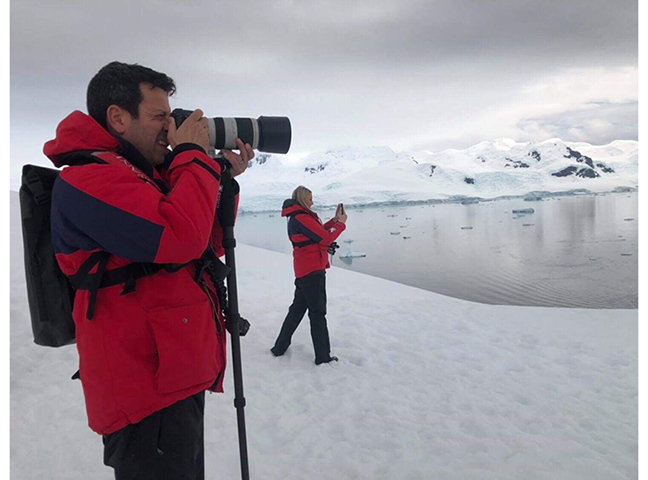
January 28, 2019 | Cuverville Island & Neko Harbour
We awoke to another gray day. Still, the clouds were high enough to reveal stunning mountains and glaciers. Our first landing was at Cuverville Island, one of the most beautiful places in the Antarctic Peninsula. Icy mountains surrounded the bay, and there was a steep hill sprawling with fresh carpets of moss.
The more physically fit went ashore first for a hike with Russ. It was also the first time we would ascend a hillside covered with snow and ice. At the end of our hike, we were rewarded with a wonderful view of icy mountains in the distance, and a sea dotted with glistening icebergs. Meanwhile, the other group members spent time watching gentoo penguins going about their business. More knowledgeable about penguin behavior than we were before, we were better able to appreciate the distinguishing aspects between the different species. The chicks were becoming too large for their parents to brood, and marauding brown skuas were patiently waiting to carry off any younglings that were not closely defended.
Our return trip to ‘Le Lyrial’ aboard the Zodiacs was a delight. The bay was choked with icebergs and ice floes revealing many shapes and dazzling colors. Back on the ship, the crew weighed anchor, and we made our way through the Errera Channel en route to Neko Harbour. At last, we would set foot on the icy continent of Antarctica. A glacier could be seen at the head of the cove, famous for calving off icebergs. Occasionally, a roar split the air, followed by a crash as an iceberg tumbled down the cliffs and splashed in the water.
Gentoos nested above the landing site. The sky was overcast, and we could feel the cold wind on our faces. Fortunately, those who accompanied Russ for a hike across the glacier would be able to keep their body temperatures up. During our trek, a glistening arrangement of white glaciers could be seen above the deep blue ocean.
Those who did not participate in the hike instead strolled beside the gentoo rookery, and the landing beach proved to be a fantastic place to observe penguins coming and going from the water. When they returned from the sea, they would move across the penguin highways carved into the snow by other penguins that had taken the path before them. Penguins marching up the hill were clean and fat with krill, while those coming down were soiled with guano and ostensibly hungry.
At Cuverville Island, we spotted several humpback whales feeding around the ship. More of these animals, along with a few minke whales, were swimming along the Errera Channel and at Neko Harbour. While our group had been privileged to see these amazing creatures up close, we wanted to catch them displaying their tail flukes during a dive. Interestingly, a humpback can be identified by its fluke’s underside or trailing edge just like a human can be identified by his or her fingerprint, and with satellite tags, individual humpback whales can even be tracked for research purposes. Photographs of these distinguishing characteristics are posted to the Happywhale website.
To cap off our action-packed day, Captain Debien attempted to cross the famous Lemaire Channel — a spectacular seven-mile-long, one-mile-wide passage between Booth Island and mainland Antarctica. Flanked by towering snow-covered mountains, the channel is nicknamed “Kodak Alley” and remains a must for any visit to the Antarctic Peninsula. It is often choked with ice, and we were forced to turn back after penetrating only one mile deep. Luckily, we still had time to appreciate its legendary beauty.
January 29, 2019 | Port Charcot & Salpêtrière Bay
Following our attempt last night to pass through the Lemaire Channel, ‘Le Lyrial’ spent the night circling in open water. In the early morning, we were approaching the landing site in Port Charcot. French explorer Jean-Baptiste Charcot navigated the bay back in 1904 and overwintered his ship ‘Français’ there. The bay is named by him for his father, a French neurologist. The weather remained cloudy, and a frosty wind blew across our cheeks. Not letting a little cold weather deter us, we enjoyed a brisk walk that would take us to more penguins, and a hike up a small hill to a cairn commemorating Charcot’s expedition.
From the landing site, there was a short climb over some smooth rocks, which led up a path through the snow to a long ridge. The A&K Expedition Team laid old towels to provide a greater foothold across the long stretches of ice. We followed the path and discovered a penguin colony containing the “grand slam” of brush-tailed penguins: gentoos, chinstraps and Adélies. From the top of the ridge, we looked out over the sea, where a myriad of glaciers glistened in the sunlight. Many of us swiftly deployed our cameras and captured some wonderful photographs. This place is sometimes called an iceberg graveyard because many icebergs are carried here on the prevailing current and left stranded.
The strength of the wind soon diminished, and our view was enhanced by reflections of the icebergs in the glassy sea.
‘Le Lyrial’ remained at anchor as we enjoyed a savory barbecue lunch. Then, we hopped aboard the Zodiacs to cruise among the icebergs in Salpêtrière Bay. Up close, the shapes and colors of the floating ice were vivid and almost bewitching. Crabeater and leopard seals rested on ice floes. From the comfort of our rides, we approached quietly on the water to photograph and observe. As if our cruise could get any better, glasses of Champagne were dispensed to toast our successful voyage.
Everyone returned to the ship, and Captain Debien turned the bows northward. In the company of several humpback whales, we headed up the Gerlache Strait, through Dallmann Bay and into the dreaded Drake Passage.
January 30, 2019 | Crossing the Drake Passage
By morning, we were well inside the Drake Passage, with open waters ahead. The sea was calm, with only a gentle wind stirring up the waves. The Drake Passage is notorious for its gales and rough seas, a result of the westerly winds that sweep unchecked around the world and are funneled between South America and the Antarctic Peninsula. The Drake Passage is named for the English privateer Sir Francis Drake, who aboard his ship, ‘The Golden Hind,’ became the first Englishman to circumnavigate the globe.
Today, we would pack for the journey home and continue our enrichment lecture program. Bob kicked things off with “Scurvy: The Scourge of Exploration.” He told us about this strange and awful disease, one often associated with early maritime travel. Scurvy occurs when the body is deprived of vitamin C, though this useful fact remained unknown for most of human history, and patients suffered ghastly symptoms such as old wounds reopening and bleeding gums. In the old days, scurvy was ascribed to poor air quality, bad digestion, tainted meat and lack of exercise. Only recently have mariners been given access to fresh fruits and vegetables, and scurvy is now considered a rare and easily remedied disease.
Marco and Patri explored the disastrous effect of longline fishing in “Seabird Conservation in Fisheries.” Longlines claim the lives of thousands of albatrosses and smaller seabirds every year. In fact, some species will become extinct if the fatality rates are not kept in check. Sadly, birds seize the baited hooks and drown as the lines are dropped over the side of fishing vessels. The good news is that there are ways of circumventing this slaughter, and the Save the Albatross global campaign is working hard to implement them.
Larry followed suit, leading a lively and well-informed lecture entitled “The Underpinnings of Climate Change: Discovering Sustainability Through a Life of Work in the Wilds.” It was fascinating to learn about his past life studying a diversity of marine mammals, from whales to sea lions. Larry was among the pioneers who began fitting these animals with recording devices. Over time, he became interested with what we as a species are doing to our planet, and what sort of future awaits humanity. After all, the human population is growing at an unprecedented rate. There are currently almost seven billion people on Earth, and the number is only rising. Global warming effects on Antarctica are also a problem. Antarctic fish, for instance, have low tolerance to changes in temperature. Declines seen in the numbers of larger animals, such as whales, narwhals, walruses and polar bears, remain a global concern. Larry believes that sustainability in the long-term must be questioned.
In what would be the day’s final lecture, Richard presented “In the Footsteps of Ansel Adams: Processing like the Masters,” teaching us the value of processing digital images with software such as Photoshop. Richard compared the work Adams (famous for his photos of Yosemite National Park) completed in the mid-20th century with the computer work completed today by digital photographers. We concluded that if Adams were alive today, he would support image processing too.
At last came the grand finale of the cruise, the Captain’s Farewell Cocktail Party. This time around, we met as friends rather than strangers. Captain Debien introduced many of the crew who contributed so much to our incredible voyage, and they were met with a booming applause.
January 31, 2019 | Ushuaia, Argentina
We looked out of the windows to gaze upon Nueva Island, which marks the entrance to the Beagle Channel. Beyond the horizon loomed more land. The swell that had caused the ship to rock gently overnight had subsided into a glassy sea.
As we approached Tierra del Fuego, Wayne presented “Earth’s Southernmost People: The Naked Indians of Tierra del Fuego and How People Came to the Americas.” Wayne provided pictures of the Yaghan tribe that were obtained in 1883 by a French photographer on an expedition down south. The pictures were vivid, displaying a group that had made a successful living in such a harsh environment. Yaghan women would dive for up to three minutes in the frigid waters of the Beagle Channel to hunt for king crabs. He also discussed the Bering Land Bridge theory and the coastal route hypothesis.
Bob presented the last of the enrichment lectures: “When I Was a Lad: Two Years in Antarctica.” We learned that Bob had spent two winters on a British Antarctic Survey research station on Signy Island in the early 1960s. Unlike other nations, Britain sent men to Antarctica for two years’ overwintering. This not only gave scientists time to collect good data but overlapping personnel ensured there were experienced men in the station. Bob shared stories about what life was like in a small and isolated community of young men, and managed to work in the adventures of Ginge the cat while he was at it.
Some of us joined the naturalists on the pool deck for some bird watching. Once we entered the Albatross Zone, there was even more to see than in the deep south of the Drake Passage. Black-browed albatrosses and sooty shearwaters effortlessly glided around the ship as we advanced up the Beagle Channel. Cape petrels and Wilson’s storm petrels flitted to and fro. We also spotted Magellanic penguins, though soon realized these would be the last penguins we would see on our journey.
Following a special afternoon tea that featured a variety of crepes prepared by our master chefs, we gathered in the theater for our final group get-together. The A&K Expedition Team, who had done so much to make this expedition cruise memorable, presented an amazing recap of our journey. The highlight was a slide show of photos and video clips that traced the entire voyage from beginning to end. So much happened in such a short span of time that the slides could not do the experience justice. There was also a raffle to benefit the Crew Welfare Fund, which raised 1,690 euros; and a raffle for Save the Albatross, which raised 2,280 euros.
After the pilot had come aboard, we found ourselves sailing between tree-clad hillsides. By late evening, the small city of Ushuaia materialized into view, and before long, ‘Le Lyrial’ had come alongside the jetty. We had time to wander into town or sit for a quiet drink with our new friends in anticipation of an early start in the morning. It had been an unforgettable voyage, and although it was sad that it was over, we would carry with us astonishing photos, stories and memories, along with a deeper understanding of the last great wilderness on our planet.
 The Americas
The Americas Europe, Middle East and Africa
Europe, Middle East and Africa Australia, NZ and Asia
Australia, NZ and Asia












































































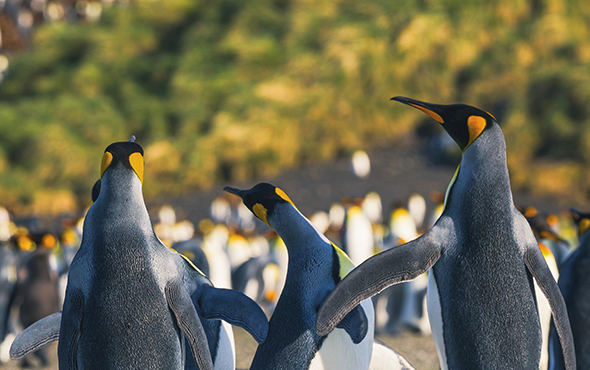
 The Americas
The Americas
 Europe, Middle East and Africa
Europe, Middle East and Africa Australia, NZ and Asia
Australia, NZ and Asia